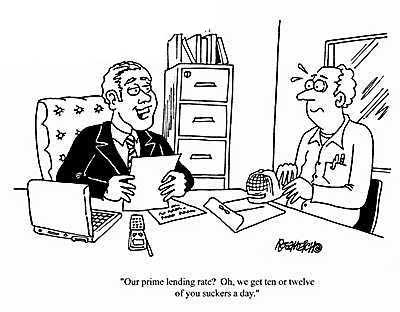"The Campbell Real Estate Timing Letter" Campbell publishes a mixed technical and fundamental report basically aimed at Southern California real estate, but which, I believe, pertains to the whole US real estate picture. Campbell doesn't simply spout his opinions, he provides real research to back up what he says.
Campbell starts his report by quoting Hemingway's classic book, "The Sun Also Rises." In the book Jake asks his friend, Bill Gorton, how he went bankrupt. Replies Gorton, "Slowly, at first, then very, very rapidly." This is what Campbell sees for Southern California real estate.
Writes Campbell, "After the most staggering real estate boom in history, housing prices all across the country are now clearly in the process of correcting from their insanely high 2005 peak valuations." Towards the end of the report, Campbell writes, "How long will the downturn last? For those of you who live in Southern California, here's a quick trip down memory lane. When the 1980 bubble burst in Los Angeles, prices took
4-6 years to recovery. When the 1990 bubble burst in Los Angeles, price
took 7-9 years to reach their previous cycle peak. . . Loose mortgage loans that prolonged the boom will worsen the bust. Homebuyers are now going to pay the price for their 'buy now, worry later' spending spree. The good news it that we will have the opportunity to buy real estate in California and in the United States at significantly lower prices than they are today."
I happen to agree with Robert Campbell. He was correct and bullish all the way up in the real estate boom. His real state index turned
bearish in August 2005, and he has been increasingly bearish ever since. He writes, that
"The current minus 48 Crash Index reading is the lowest since December 1991, a potentially very ominous sign."But here's the main point I considered after reviewing all his research. For the sake of argument, suppose Robert Campbell is correct. Suppose we are in for an accelerating, multi-year bust in real estate and particularly in Southern California real estate? If that happens, then all bets are off. This will be the major event of the year and for many years. It will affect all the economies of the world. It will affect everything because if we experience a real estate bust, US consumers will reverse their consuming habits, they will struggle to pay off mortgage debt. Sentiment will change, debt will become a dirty word, and Americans will start to save again.
And if you don't think that will impact the world economy, then you're living on another planet. Remember, the US Gross Domestic Product represents 25% of the world economy. No other nation's economy even comes close. The world has prospered during recent years on the insatiable buying activities of Americans. If that slows down, the world economy will slow down. Everything slows down, even China and India will slow down. What I'm talking about here is a world event. And it all hangs on US real estate, and whether the real estate bubble gives way to what I term a hard, a very hard, landing.
Next question -- what do we do or where do we put our money if the potential hard landing becomes a reality? This is a very tough question with no sure-shot answer. My own inclination is to opt for T-bills and an investment in gold. You may want to include smaller investments in selected stock groups, but I think T-bills should be your major position.
Won't the Fed enter the picture with even more massive injections of liquidity? The answer is yes, if housing falls apart the Fed will open the liquidity spigots and bring interest rates down. But how will this help homeowners who are unable to service their mortgages? Answer -- lower rates will tend to mitigate some mortgage payers, but in general people with low "teaser rate" mortgages will find their payments higher, despite what the Fed does.
The whole picture I'm trying to present is one in which housing is shaky, stocks are overvalued, bonds are a question market, and the best strategy is what appears to be the safest strategy.























